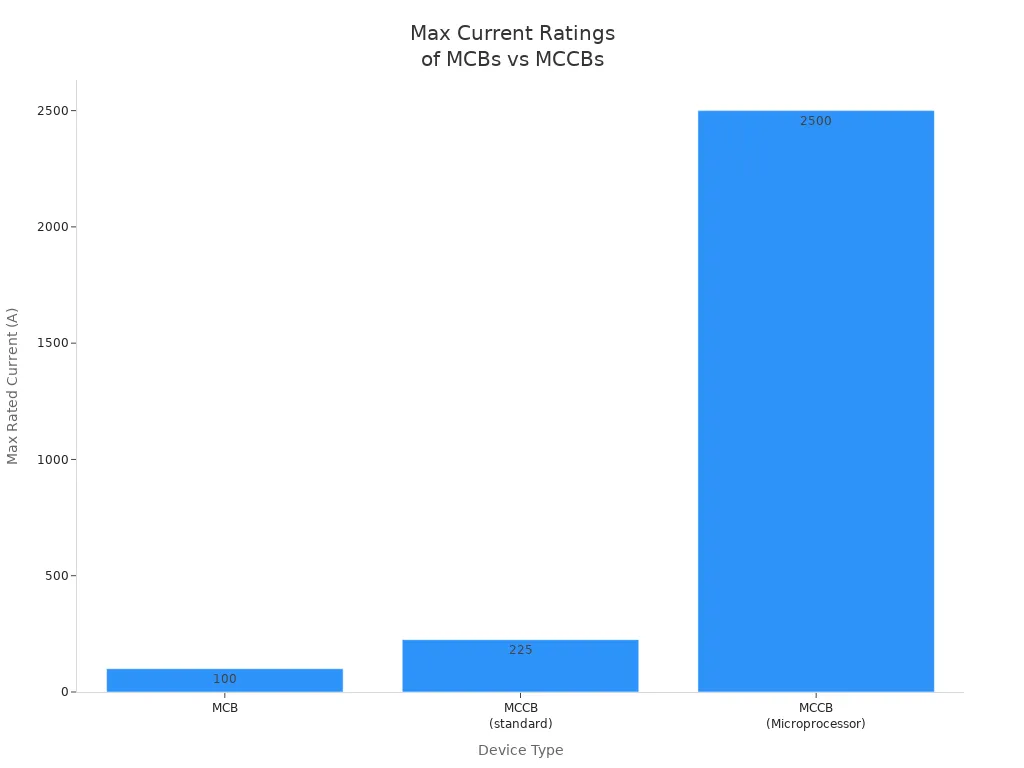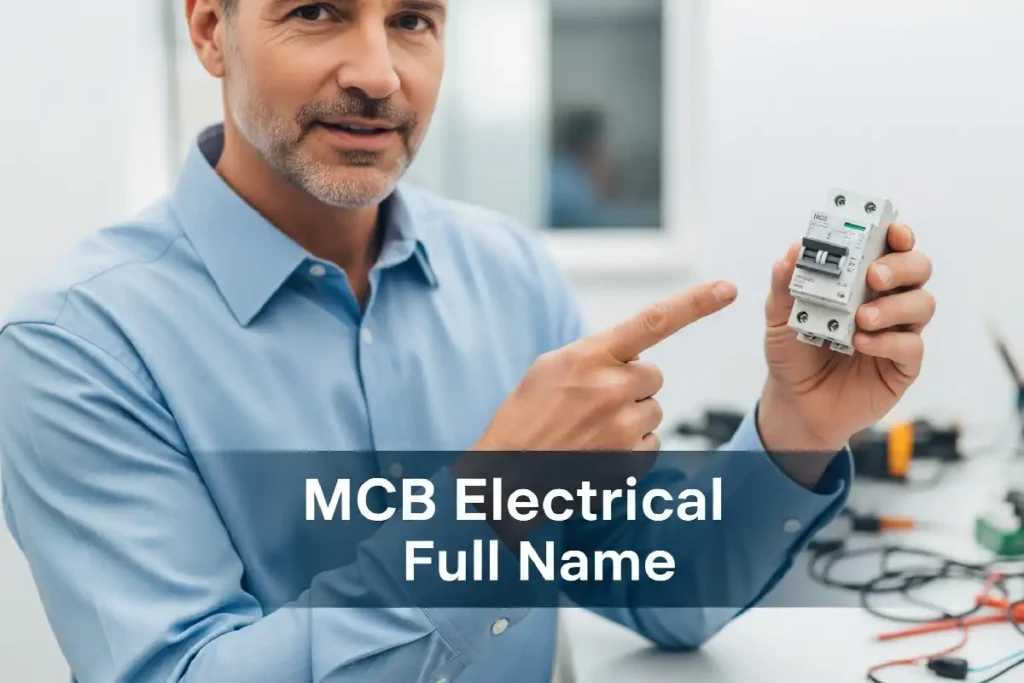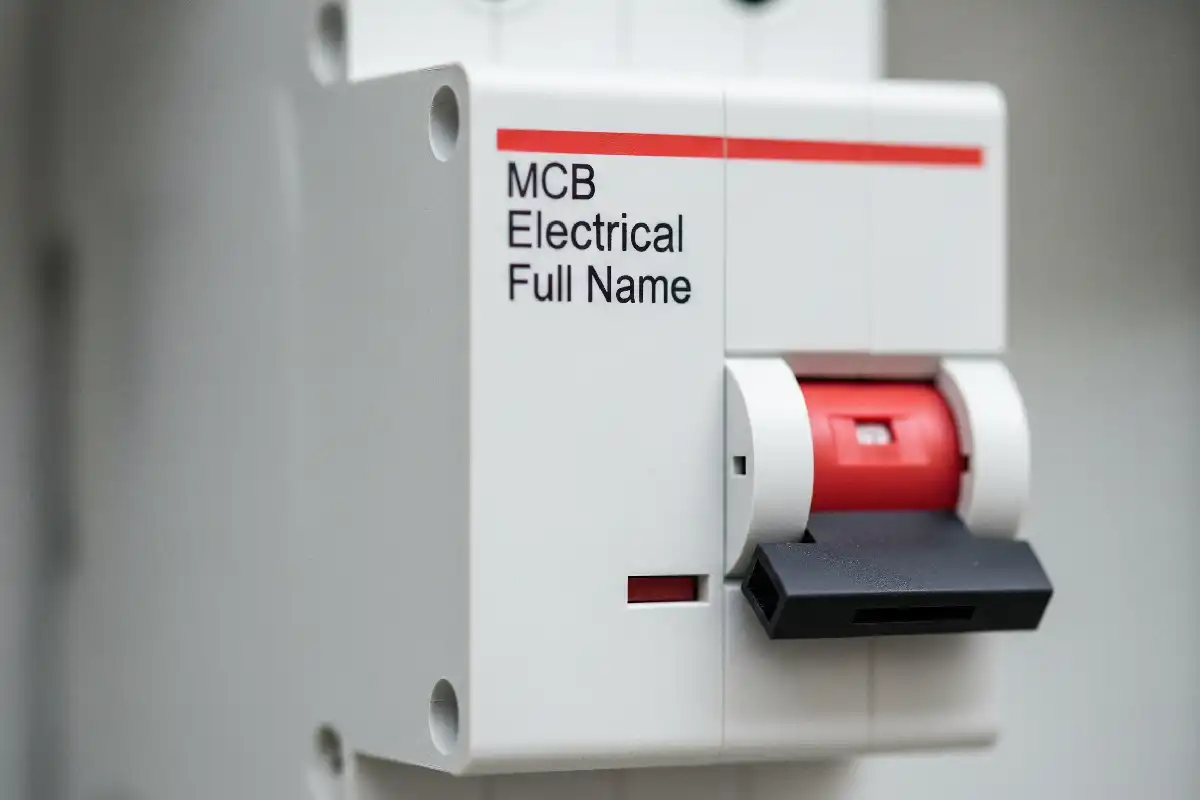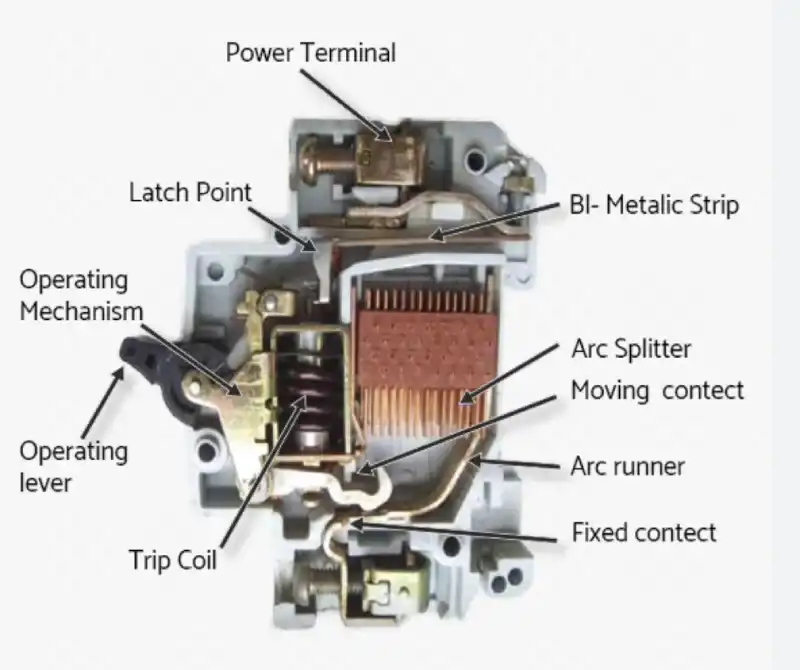You often see the word MCB in electrical systems. MCB means miniature circuit breaker. This is a very important safety device. If you know the mcb full form and the mcb electrical full name, you can understand how it keeps your home or work safe. Knowing the full form of mcb helps you spot key details. These details include the brand name, model, and rated current. The table below explains why each part of the mcb electrical full name is important for safety:
| Specification | Description | Safety Relevance |
|---|---|---|
| Brand Name | Manufacturer identity | Makes sure the mcb works well |
| Product Name (Model) | Exact mcb model | Helps you find the right instructions |
| Tripping Curve & Rated Current | Current-time characteristics, max load | Stops overloading and keeps circuits safe |
You can see that knowing the mcb full form helps you choose or check a miniature circuit breaker with more confidence.
Key Takeaways
- MCB means Miniature Circuit Breaker. It is a small device. It protects electrical circuits by stopping too much current fast.
- MCBs work by themselves to stop damage from too much power or short circuits. You can reset them easily after you fix the problem.
- There are different types of MCBs for different places. Type B is for homes. Type C is for offices. Type D is for factories with big machines.
- MCBs are better than fuses because you can use them again. You can reset them, which saves time and money over time.
- To pick the right MCB, check its rated current, tripping curve, and brand. This helps keep your circuits safe and working well.
MCB Electrical Full Name
MCB Full Form
You might see mcb in many electrical systems. The mcb full form is “miniature circuit breaker.” People use this term in books and manuals. You will also find it in research articles. When you read about electrical safety, you will see the mcb full form. It means a device that keeps circuits safe from harm. You can spot the mcb electrical full name on the device, in catalogs, and in technical rules.
Tip: Always look at the mcb full form and mcb electrical full name before you put in or change a breaker. This helps you pick the right one for your circuits.
The mcb full form is known all over the world. You will see it in science papers, mostly about power and clean energy. Researchers use miniature circuit breaker when they talk about smart features. These include remote checks, arc control, and digital tools. Experts and teachers use mcb full form to talk about safety for homes and small devices. The mcb electrical full name is important. It shows the device is small, works well, and fits modern circuits.
- Miniature circuit breaker is a common word in engineering.
- You will see mcb full form in studies about power and smart grids.
- Industry and schools use mcb electrical full name to teach safety and how to pick devices.
- The mcb full form is in guides for home and business circuits.
Meaning of Miniature Circuit Breaker
When you see the mcb electrical full name, it means miniature circuit breaker. This device keeps circuits safe by turning off if there is too much current. The mcb uses a bimetallic strip and a solenoid coil to sense trouble. If the current gets too high, the mcb trips and stops the flow. You can turn the mcb back on after you fix the problem. This is easier than using a fuse.
The miniature circuit breaker was first made in the early 1900s. Hugo Stotz made the first mcb in 1923. He wanted to replace fuses with something you could use again. The mcb electrical full name shows it is small and works by itself. Early mcbs fit into old fuse spots, so you did not need new wires. Over time, the mcb full form became a normal word in electrical work.
Global rules say a miniature circuit breaker is a small device that stops too much current. Rules like IEC 60898-1 and IEC 60947-2 tell how mcbs should work in homes and factories. These rules say mcbs must act fast, trip every time, and pass tough safety tests. You can trust an mcb to keep your circuits safe because it follows these rules.
Here is a table that shows the main parts inside a miniature circuit breaker:
| Component | Description |
|---|---|
| Latch | Keeps the breaker ON and lets go to trip when there is a problem. |
| Solenoid | Acts fast to surges and moves the plunger to trip the breaker. |
| Switch | Lets you turn it on or off and shows if it is working. |
| Plunger | Moves to make the latch let go and break the circuit. |
| Incoming Terminal | Connects the live wire to the mcb. |
| Arc Chutes Holder | Holds arc chutes and guides arcs away safely. |
| Arc Chutes | Metal plates that cool and stop electrical arcs. |
| Dynamic Contact | Moving part that opens or closes the circuit. |
| Fixed Contact | Still part that lets current flow well. |
| DIN Rail Holder | Lets you put the mcb on a DIN rail in boards. |
| Outgoing Terminal | Sends current to the load after it goes through the mcb. |
| Bi-metallic Strip Carrier | Holds the bi-metallic strip so it works right. |
| Bi-metallic Strip | Bends when hot to trip the breaker if there is too much current. |
You can see the mcb electrical full name means a device with many ways to keep you safe. The miniature circuit breaker keeps your circuits safe with smart parts and strong rules. When you pick an mcb, you get good protection for your circuits at home, school, or work.
MCB Function and Use
How MCB Works
You use an MCB to keep circuits safe from damage. The mcb full form, miniature circuit breaker, means it works by itself. If too much current flows, the MCB finds the problem and turns off the circuit. You do not have to buy new parts after it trips. You just reset the MCB when you fix what is wrong.
MCBs protect in two main ways:
- Overload protection: The MCB trips if the current is too high for too long. This stops wires from getting too hot and starting fires.
- Short circuit protection: The MCB sees very high currents and shuts off the circuit right away. This keeps your wires and devices safe.
Inside an MCB, two parts help it trip. The thermal part works for overloads. A bimetallic strip gets hot and bends when there is too much current. This opens the contacts and stops the flow. The magnetic part works for short circuits. A solenoid coil makes a strong magnetic field when there is a surge. This pulls a lever and opens the contacts fast.
Here is a table that shows how these parts work during problems:
| Component | Function during Faults | Operation Detail |
|---|---|---|
| Thermal Element | Works when there is too much current for a while | A bimetallic strip heats up and bends, which opens the circuit. |
| Magnetic Element | Works when there is a sudden, big surge | A solenoid coil makes a magnetic field, pulling a lever to open the contacts right away. |
| Result | Both parts make the MCB stop the current and protect the circuit until you reset it. | The MCB opens its contacts to stop electricity, so nothing gets hurt. |
MCBs trip at different speeds for different problems. For overloads, it can take seconds or minutes to trip. For short circuits, it trips in less than a second. This quick action keeps your circuits safe from harm.
Note: Always check the mcb full form and curve type before you put one in. This helps you pick the right MCB for your needs.
Applications of MCB
You see MCBs in many places because they stop overcurrent and other problems. The mcb full form, miniature circuit breaker, is used in homes, stores, and factories. You use MCBs for lights, machines, and other equipment.
Here are the most common ways people use MCBs:
- Homes: MCBs protect lights, kitchen tools, and air conditioners. Type B MCBs are best for homes because they handle small surges.
- Commercial buildings: Offices, stores, and hotels use MCBs for computers, air systems, and lights. Type C MCBs work well here because they handle medium surges from things like motors.
- Industrial places: Factories need MCBs for big machines and motors. Type D MCBs are good for these jobs because they handle large surges.
Here is a table that shows where each MCB type is used:
| MCB Type | Common Installation Locations | Typical Applications / Loads |
|---|---|---|
| Type B | Homes and small businesses | Circuits with small surges: lights, small tools, home wiring |
| Type C | Stores and light factories | Medium surges: bright lights, air systems, small motors |
| Type D | Big factories | Large surges: big motors, welding tools, big transformers |
| Types K & Z | Special factories and sensitive tools | Factory motors (K), medical tools (Z) |
You also find MCBs in bakeries, stores, and hotels. These places use MCBs to keep power steady and stop problems. In factories, MCBs protect heaters and big machines from high voltage. Some MCBs have ground fault and arc fault trips. These help you find problems and turn off the breaker for more safety.
Modern MCBs have smart features. You can watch energy use live and control loads better. Some miniature circuit breaker models use special parts to find problems faster. You get better protection and save more energy. Smart MCBs help you use less power and keep things safer.
Tip: When you pick an MCB, look for smart features like IoT and easy-to-change parts. These make your circuits safer and easier to fix.
You use MCBs in many places because they protect against too much current. The mcb full form, miniature circuit breaker, means you get fast switching, quick response, and easy reset. You keep your circuits safe at home, at work, and in factories.
MCB vs Other Circuit Protection Devices
When you look at ways to protect circuits, you find many devices. The most common ones are the mcb, fuse, and moulded case circuit breaker. All of these protect circuits from too much current. But they work in different ways and are good for different jobs.
MCB vs Fuse
You often pick between an mcb and a fuse for simple circuit safety. Both stop too much current, but they are different in how you use and fix them. An mcb, or miniature circuit breaker, can be reset after it trips. You do not need to buy a new one. A fuse must be changed every time it blows. This makes the mcb easier to use for most people.
Here is a table that shows the main differences:
| Aspect | Miniature Circuit Breaker (MCB) | Fuse |
|---|---|---|
| Reusability | Reusable; reset by flipping a switch | Non-reusable; must be replaced |
| Reset Mechanism | Simple switch flip for quick power restoration | Replacement required, more time-consuming |
| Maintenance | Periodic testing by flipping on/off | Visual inspection; replace if blown |
| Cost | Higher upfront, long-term savings | Lower upfront, ongoing replacement |
| Convenience | Quick reset | Time-consuming replacement |
| Current Rating | Usually 6A and above | Can be as low as 1A |
You can see that mcbs are easier to take care of and save money over time. Fuses cost less at first, but you spend more later. If you need to turn power back on fast, like at home or in an office, the mcb is a better pick.
Note: Fuses can protect circuits with very small currents, even 1 amp. MCBs usually start at higher numbers, so check what you need before you choose.
MCB vs MCCB
If you need to protect bigger circuits or heavy machines, you compare the mcb with the moulded case circuit breaker. The mcb is best for small jobs, like lights and little devices. The moulded case circuit breaker can handle much more current and has more features.
| Feature | Miniature Circuit Breaker (MCB) | Moulded Case Circuit Breaker (MCCB) |
|---|---|---|
| Rated Current | 1A to 100A | 16A to 225A (standard), up to 2500A (advanced) |
| Breaking Capacity | Up to 10-15 kA (mcb breaking capacity) | 10 kA to 100 kA or more |
| Trip Settings | Fixed | Adjustable |
| Protection Scope | Overload, short circuit | Overload, short circuit, ground fault |
| Applications | Homes, small offices, light commercial | Factories, large buildings, heavy machinery |
| Size | Compact, DIN rail mount | Larger, needs more panel space |
| Customization | Minimal | High, with accessories and remote control |
You can see the difference in current ratings in this chart:

You use an mcb for most home and office circuits. The moulded case circuit breaker is best for factories or places with big machines. MCCBs let you change trip settings, which helps in tricky systems.
Tip: Always pick the right device for your job. Use an mcb for simple, small circuits. Pick a moulded case circuit breaker for big or factory jobs.
You might also see other protection devices, like the residual current device and the residual current circuit breaker. These keep you safe from electric shock and leaking current. They work with mcbs and MCCBs to give you full safety in many places.
Knowing the mcb electrical full name helps you see why it is important for safety. The mcb keeps your circuits safe by turning off power fast when there is danger. You get better safety, can reset it easily, and do not need to fix it as much as a fuse. The mcb works well in homes, offices, and factories. This makes it a good choice for keeping circuits safe. When you pick an mcb, you help make your electrical system safer and more reliable.
Remember: The mcb gives you quick, reusable, and accurate protection. It keeps your wires and devices safe every day.
FAQ
What does MCB stand for in electrical systems?
MCB stands for Miniature Circuit Breaker. You use it to protect electrical circuits from too much current. It helps keep your home and devices safe.
What happens when an MCB trips?
When an MCB trips, it stops the flow of electricity. You can reset it by flipping the switch after you fix the problem. This keeps your circuit safe from damage.
What makes an MCB different from a fuse?
You can reset an MCB after it trips. You must replace a fuse every time it blows. MCBs save you time and money.
What types of MCBs can you find?
You find Type B, Type C, and Type D MCBs. Type B works best for homes. Type C fits offices and stores. Type D protects big machines in factories.
What should you check before choosing an MCB?
You should check the rated current, tripping curve, and brand name. These details help you pick the right MCB for your circuit and keep everything safe.
See also
What Is an Arc in a Circuit Breaker and Why Does It Matter
How to Tell When a Distribution Board Is Overloaded
Electric motor circuit breaker selection and usage
The difference between miniature circuit breakers and fuses
How to Match the Type of MCB to Your Electrical Load





